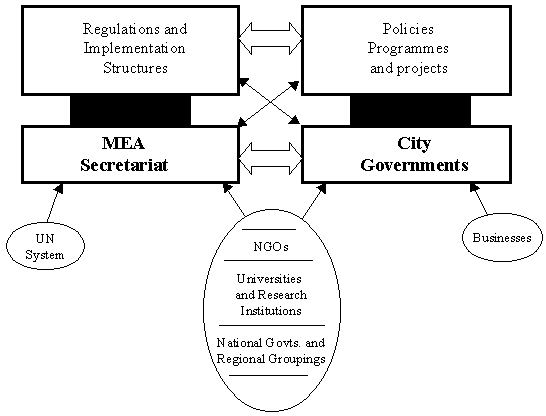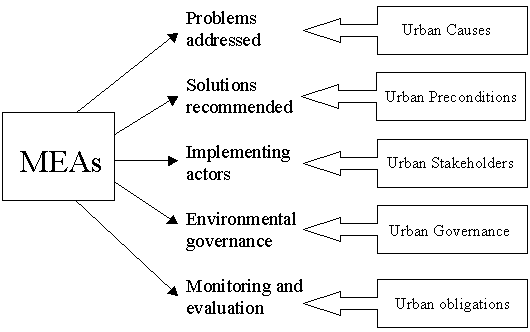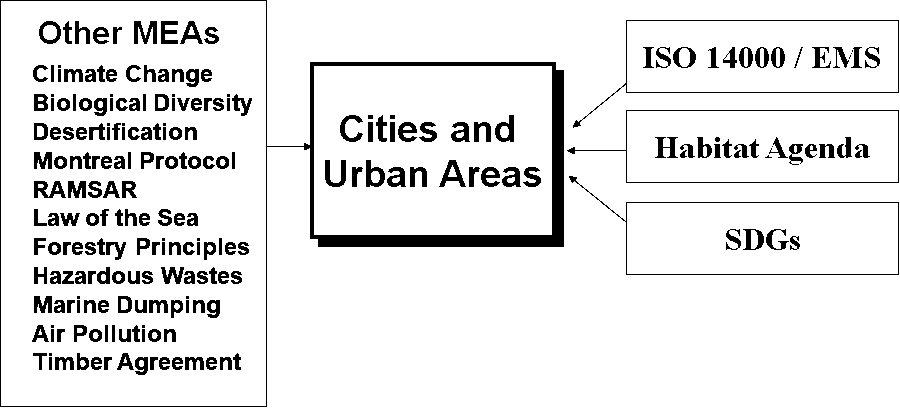 |
Hari Srinivas |
|
Continuing Research Series E-176. January 2023
|
 ake any of today's environmental problems faced by the inhabitants of this planet, and its causes and pressures can be traced back, directly or indirectly, to cities and its residents' lifestyles and consumption patterns. The forces and processes that constitute 'urban activity' have far-reaching and long-term effects not only on its immediate boundaries, but also on the entire region in which it is positioned. For example, the resources necessary to maintain a city of the size of Greater Tokyo require a land area that is about three and a half time that of entire Japan. ake any of today's environmental problems faced by the inhabitants of this planet, and its causes and pressures can be traced back, directly or indirectly, to cities and its residents' lifestyles and consumption patterns. The forces and processes that constitute 'urban activity' have far-reaching and long-term effects not only on its immediate boundaries, but also on the entire region in which it is positioned. For example, the resources necessary to maintain a city of the size of Greater Tokyo require a land area that is about three and a half time that of entire Japan.
But population concentration in increasingly smaller land masses has caused a drastic decline in the quality of living both in the residential and work areas. Cities have, in effect, become a barometer of humankind's progress into the 21st century. Such a scenario has had ripple effects on a variety of sectors such as education, health, labour/job markets, and economic activities.
The concern and problems associated with urban areas and the environment in general have placed such issues high on the agenda of many bilateral and multilateral meetings. The Earth Summit of 1992 in Rio de Janeiro managed to highlight and channel efforts in understanding and acting on environmental problems, making it a key issue to be tackled in trade and commerce, in economic and social development, and in science and technology. Subsequent summits and congresses such as the Social Summit and the Beijing Conference on Women in 1995, the City Summit/Habitat II in 1996, not to mention innumerable regional, national and local meetings, all have had the larger global environment as an important common denominator in its action plans.
One of the key outputs of the 1992 Rio Summit was the spawning of a host of conventions, agreements and declarations related to different environmental issues (collectively called the 'Rio Agreements')
1UNDP, 1997 _Synergies in National Implementation: The Rio Agreements_. New York: Sustainable Energy and Environment Division, United Nations Development Programme.
. These activities have generated a number of multilateral environment agreements (MEAs), most recent of them being the Kyoto Protocol on climate change promulgated in Kyoto, Japan December 1997.
Each of these MEAs require that countries develop specific implementation mechanisms and fulfil obligations involving reporting, training, public education, and other activities 2Source: Press Kits and Info Sheets from the Convention Secretariats of climate change, biodiversity and desertification.. The MEA themes, in fact, lie at the heart of industrial transformation issues of eco-efficiency, land degradation, eutrofication, energy systems, technology innovation, etc. Incentive structures mentioned in the IT Science Plan3Source: Pier Vellinga, _Building a Research Agenda on Industrial Transformation as part of the International Human Dimensions Programme of Global Environmental Change (IHDP)_. IHDP-IT East Asia Workshop, Kita-Kyushu, Japan, June 24-25, 1998. - fiscal systems, trade systems and liability systems - have also been proposed as a means of realising the goals of these MEAs.
Urban Areas and Climate Change
The link between the climate change agreements (under the aegis of the UNFCCC) and urban environments is a two-way street. Urban areas effect and are affected by climate change (and its primary villain, CO2) both directly and indirectly. The mega concentration of people and industry in cities are a major contributor to CO2 emissions. For example, more than 400 vehicles are added to the already congested streets of Bangkok everyday. Urban activities (vehicles, industrial activities, garbage incineration etc.) generate a considerable amount of CO2. Higher CO2 levels undoubtedly affect urban dwellers, in terms of respiratory illness, higher temperatures, and a host of related maladies.
But 'climate change' is more than just CO2 levels. It is more than global warming or ozone depletion. Climate change is more than the sum of its parts. Rain patterns may change, climate and agricultural zones may shift towards the poles, melting glaciers and thermal expansion of sea water may raise sea levels, threatening low-lying coastal areas and small islands - the cause-and-effect patterns are endless.
Combating the effects of climate change, from an urban perspective, requires a concerted framework within which disparate actions can be positioned and brought together - so that collective effects and efforts can be realised. A cooperative rather than a confrontational approach needs to be adopted, where local actions at the grassroots level add up to a more balanced environmental existence.
|
The research focuses on MEAs that are specifically directed at cities, including the SDGs and the New Habitat Agenda, and implications of other MEAs on cities (See Figure 1). The research has two components: firstly, it will attempt to build synergies between urban areas and the MEAs in a two way process - how do cities contribute to the conditions and problems addressed by these MEAs?

Figure 1: The MEA-Urban Link
And on the reverse flow, how do these MEAs affect the natural, built-up and social environments of cities? Secondly, it will establish the overlaps, commonalties, inherent relationships and mutual dependencies between these MEAs, focusing on the role of cities and urban stakeholders (See Figure 2). The research is grounded in a comprehensive inventory of MEAs with its corresponding urban implications.

Figure 2: MEA Implications for Urban Areas
The genesis of the research lies in the fact that effective implementation of MEAs lies in strong local and urban governments that can take decisive steps at the local level, particularly for urban areas (See Figure 3). This calls for a framework of supporting institutions (including the MEA secretariats) at all levels, that support and prop-up urban authorities.

Figure 3: Institutional Linkages
It is well recognized that MEAs are important for cities because:
- They provide a framework for international cooperation to address environmental issues.
- They set standards and goals for reducing environmental impacts and promoting sustainability.
- They provide access to funding and technical assistance for cities to implement sustainable development projects.
- They help to ensure consistency in environmental policies and regulations across countries.
- They raise awareness of environmental challenges and encourage local action.
The research is a project of the Urban Environmental Management research programme of GDRC. It draws the key implications of each MEA from an urban point of view, using secondary data, and will be supported by case studies of specific actions taken by urban governments and other stakeholders. It also includes field research and explorations, through GDRC's fellows and partners. It builds on an earlier GDRC Project called "Trialogue" that takes a cross-platform view of the three conventions of climate change, biodiversity and desertification as a means of comparing, correlating and consolidating activities and information related to the three conventions.
|